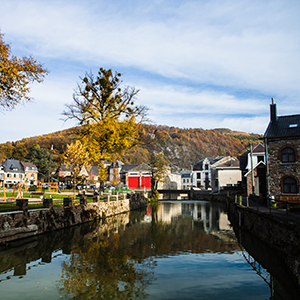Military Heritage
Castles and fortresses
Château de la Motte (Dorinne)
this got its name from the old tenant farm of La Motte, acquired by the Brant family in 1591 through Charles de Glymes. The chateau was burned down by the Germans in 1914 and rebuilt in 1922 with fine local stone on another site.
Evrehailles castle (Evrehailles)
depicted c. 1604 by Adrien de Montigny in one of Charles de Croÿ's albums, the castle was the centre of a town fiefdom as early as the 13th century and had to be rebuilt in the 16th century, by either the Montjoies or the Roseys. The castle appears to have originally consisted of a quadrangular enclosure surrounded by water, with a circular corner tower on either side. The stonework is almost entirely dressed sandstone masonry and blue stone.
The castle (Godinne)
known as the Priory, it was built by Henri de Wildre, Provost of Poilvache in the early 16th century. It is now the private property of Dr. Mathy. It was built from brick and limestone. A distinctive feature of the castle is its stepped gable, which used to be very common but is now quite rare. It was the residence of the Lords of Godinne, whose coats-of-arms can be found in various places.
The Chateau Gaiffier (Houx)
this is a large, U-shaped brick building dating back to 1795. The classical-style chateau boasts extensive grounds. Close to the chateau, there is a beautiful blue stone fountain with water pouring out of a number of spouts.
The Chateau de Blocqmont (Houx)
this is located in the higher woodlands, towards Poilvache, and owes its origins, in 1601, to owner Nicolas Blocq (Blocq Mont). The Chateau de Blocqmont, built in the mid-18th century, is a classical two-storey brick building.
The Chateau de Poilvache (Houx)
the ruins of the ancient fortress of Poilvache can be seen perched on top of a very high rock. It was first built in 1226-1228. It was the work of Waleran de Montjoie, Duke of Limbourg, and his wife, Isabelle de Bar, Countess of Luxembourg. The original name of the castle (Smaragdus – the Latin for Emerald) comes from that of a Frankish man, Meraldus. It was known from the 13th century onwards as "Poilvache". This name was given to the inhabitants of the castle by the Dinantais and Hutois, because they stole pigs and cows - even from farm buildings. The castle was also known by the ancients as Castrum Bohemorum.
The castle was besieged, stormed and ruined by the Dinantais, in 1322. The Liegeois besieged it in 1430. After a vigorous and sustained defence lasting 5 to 6 days, the garrison surrendered and the castle was razed to the ground. Having been re-built, it was completely demolished by the French army in 1554. All that can now be seen of this ancient feudal high place are a few remains of underground passages and a 55m-deep well bored into the rock.
The ruins are now the property of the region of Wallonia and were listed as Outstanding Heritage in 1992. http://www.poilvache.be/
Spontin Castle (Spontin)
this illustrates the changes in lordly residences from the Middle Ages to the present time. Originally, around the 12th century, Spontin Castle was a square "defensive tower" built on an islet in the Bocq. It was intended to protect the users of the old Roman road between Dinant and Huy. After armed exploits, at the end of the 12th century, the Knight of Spontin, Guillaume known as the "Ardennais", transformed the original building into a 3-storey fortified residence with thicker walls and added 2 small defensive towers with drawbridges. It was not until the 14th century that the building began to look like a traditional castle. In the 16th century, as the fortifications had now become useless (following the invention of gunpowder), the castle was transformed into a stylish residence - windows were made and the present roofs were built on the towers. The two most recent transformations were the construction of a fortified farm along the facade (17th century) and the demolition of some of the rear fortifications. The fortified farm currently houses the tourist facilities which make Spontin one of the prime tourist destinations in Namur. The fortified enclosure (Spontin): there were 6 towers to defend the castle from enemies from every direction. Four were closer to the castle: Senenne, La Rochette, Bailoy and Durnal ; two were further away: Mouffrin and Stier. The latter was the most powerful of all with its manor, water mill, cowshed and outbuildings.
The Chateau de Bouvignes (Yvoir)
this was built in 1751. This old ironsmith's house stands on the foundation of a previous tower which is thought to have served for defensive purposes. This building is currently owned by the province of Namur.
Château Dapsens (Yvoir)
this is the former Chateau Gaiffier. There is an old lookout tower, which is older than the rest of the building, and which was probably part of the old castle belonging to the Lords of Yvoir. Behind Chateau Dapsens there is a chapel which was built in 1688, with an remarkable marble altar and two fine wooden statues of Saint Peter and Saint Roch.



